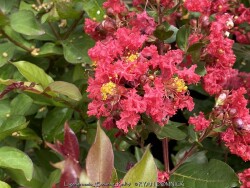

Crapemyrtle (Lagerstroemia) is a beautiful summer flowering shrub that dies down to the ground as a perennial each year in Zone 6 Kansas. Flower colors include bright red, pink, magenta, purple, and white. Many cultivars have been released improving foliage color, disease resistance, and flower blooming length. Newer cultivars now have maroon or reddish foliage adding interest before blooming. Beautiful fall color is often overlooked; shades of red, orange, and purple develop when Night temperatures reach into the 40s. In Kansas, crape myrtles grow best with hot south or west exposures or on south facing berms or hillsides. But they are suitable in any garden location as long as they are in full sun, they will build enough energy to come back from complete winter top-kill each year. Generally are 40 inches of rain per year is sufficient without extra watering, but if drought conditions occur, flowering will be reduced or shortened. Brief periods of excessive water and saturated soils are tolerated adding to their versatility. Many people from the south associate Crapemyrtles as a tree. That is true that in Texas and much of the Southeast, beautiful tree forms with exfoliating bark will occur because of mild winters. In Oklahoma and Arkansas for example crapemyrtles are usually grown as large shrubs experiencing major winterkill every 5-10 years. In Kansas and Missouri, or where temperatures regularly get to 0°, all top growth will die back and they will be grown as a woody perennial. After flowering and beautiful fall color is dropped, many people leave crapemyrtles throughout the winter to enjoy the winter interest of the dried seed heads. By March or April, cut plants close to the ground and watch for new growth. Flowering occurs on new wood and is much larger and more dramatic on sprouts from the ground. Flowers are often twice as big when grown this way. In the past, only fast-growing tree size cultivars for appropriate and Kansas because they have the ability to recover the fastest from complete winterkill and grow into a flowering-sized shrub by July. Now there are dwarf cultivars that are wood-hardy to -10 zone 6 for those not wanting to worry about winterkill. No disease or pest problems. Crapemyrtle are awesome for pollinators in the late season garden and especially effective when combined with vitex, butterfly bush, and/or caryopteris. Enduringtm Red Crapemyrtle (Lagerstroemia 'PIILAG B5') features clusters of bright true scarlet-red blooms appear all summer against the glossy green foliage. Leaves emerge red and turn to dark green. This mid-size variety grows 4 to 5 feet tall and wide with a tight growth habit. Developed by Greenleaf Nursery Company as part of the Garden Debut® Collection.
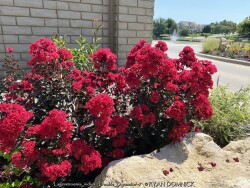

Crapemyrtle (Lagerstroemia) is a beautiful summer flowering shrub that dies down to the ground as a perennial each year in Zone 6 Kansas. Flower colors include bright red, pink, magenta, purple, and white. Many cultivars have been released improving foliage color, disease resistance, and flower blooming length. Newer cultivars now have maroon or reddish foliage adding interest before blooming. Beautiful fall color is often overlooked; shades of red, orange, and purple develop when Night temperatures reach into the 40s. In Kansas, crape myrtles grow best with hot south or west exposures or on south facing berms or hillsides. But they are suitable in any garden location as long as they are in full sun, they will build enough energy to come back from complete winter top-kill each year. Generally are 40 inches of rain per year is sufficient without extra watering, but if drought conditions occur, flowering will be reduced or shortened. Brief periods of excessive water and saturated soils are tolerated adding to their versatility. Many people from the south associate Crapemyrtles as a tree. That is true that in Texas and much of the Southeast, beautiful tree forms with exfoliating bark will occur because of mild winters. In Oklahoma and Arkansas for example crapemyrtles are usually grown as large shrubs experiencing major winterkill every 5-10 years. In Kansas and Missouri, or where temperatures regularly get to 0°, all top growth will die back and they will be grown as a woody perennial. After flowering and beautiful fall color is dropped, many people leave crapemyrtles throughout the winter to enjoy the winter interest of the dried seed heads. By March or April, cut plants close to the ground and watch for new growth. Flowering occurs on new wood and is much larger and more dramatic on sprouts from the ground. Flowers are often twice as big when grown this way. In the past, only fast-growing tree size cultivars for appropriate and Kansas because they have the ability to recover the fastest from complete winterkill and grow into a flowering-sized shrub by July. Now there are dwarf cultivars that are wood-hardy to -10 zone 6 for those not wanting to worry about winterkill. No disease or pest problems. Crapemyrtle are awesome for pollinators in the late season garden and especially effective when combined with vitex, butterfly bush, and/or caryopteris. Lagerstroemia indica 'Double Dynamite' is a new variety from Dr. Carl Whitcomb. It would be notable simply for its vivid cherry-red flowers and deep purple foliage, but its ability to bloom continuously on the same panicle make it positively extraordinary. Enjoy over 100 days of bloom on a handsome, disease resistant plant.
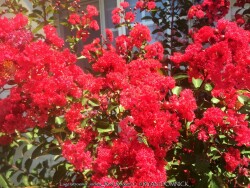

Crapemyrtle (Lagerstroemia) is a beautiful summer flowering shrub that dies down to the ground as a perennial each year in Zone 6 Kansas. Flower colors include bright red, pink, magenta, purple, and white. Many cultivars have been released improving foliage color, disease resistance, and flower blooming length. Newer cultivars now have maroon or reddish foliage adding interest before blooming. Beautiful fall color is often overlooked; shades of red, orange, and purple develop when Night temperatures reach into the 40s. In Kansas, crape myrtles grow best with hot south or west exposures or on south facing berms or hillsides. But they are suitable in any garden location as long as they are in full sun, they will build enough energy to come back from complete winter top-kill each year. Generally are 40 inches of rain per year is sufficient without extra watering, but if drought conditions occur, flowering will be reduced or shortened. Brief periods of excessive water and saturated soils are tolerated adding to their versatility. Many people from the south associate Crapemyrtles as a tree. That is true that in Texas and much of the Southeast, beautiful tree forms with exfoliating bark will occur because of mild winters. In Oklahoma and Arkansas for example crapemyrtles are usually grown as large shrubs experiencing major winterkill every 5-10 years. In Kansas and Missouri, or where temperatures regularly get to 0°, all top growth will die back and they will be grown as a woody perennial. After flowering and beautiful fall color is dropped, many people leave crapemyrtles throughout the winter to enjoy the winter interest of the dried seed heads. By March or April, cut plants close to the ground and watch for new growth. Flowering occurs on new wood and is much larger and more dramatic on sprouts from the ground. Flowers are often twice as big when grown this way. In the past, only fast-growing tree size cultivars for appropriate and Kansas because they have the ability to recover the fastest from complete winterkill and grow into a flowering-sized shrub by July. Now there are dwarf cultivars that are wood-hardy to -10 zone 6 for those not wanting to worry about winterkill. No disease or pest problems. Crapemyrtle are awesome for pollinators in the late season garden and especially effective when combined with vitex, butterfly bush, and/or caryopteris. Lagerstroemia indica 'Red Rocket', developed by Dr. Carl Whitcomb, features brilliant cherry-red flowers with dark green foliage. It is one of the fastest growing crape myrtles reaching 4-6' in one season when cut to the ground in Kansas.


***Description for this plant available with future update!***
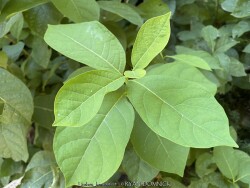

Native Spicebush (Lindera benzoin) is a multi-stemmed, irregularly rounded understory shrub native to eastern North America, including Eastern Kansas. Foliage is a matte bright green then turning an attractive yellow in autumn. The yellow flowers grow in showy clusters appearing in early spring before foliage emerges. Flowers on male and female plants look noticeably different. The flowers have sepals in place of petals and a very sweet aroma. Red berries are produced if a male and female plant are close together. Nutritious fruit is quickly eaten by several bird species. Full shade to part shade is best with average to moisture-retentive rich soils. Height reaches 6-9' tall in Kansas and Missouri. The name "Spicebush" comes from foliage and stems that are aromatic when bruised. Spicebush tolerates alkalinity, and in the wild is sometimes found in soils with exposed limestone. Some drought is tolerated if planted in shade; dry-shade experiments are in progress in Lawrence, KS. Use in the landscape as a wildlife friendly background shrub or grouping in shade gardens.
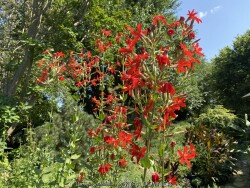

Cardinal Flower / Native Lobilia, is also known as Lobelia cardinalis
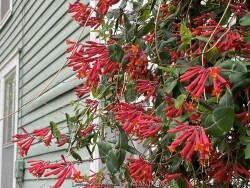

Coral Honeysuckle / American Honeysuckle (Lonicera sempervirens) is native to eastern North America. It is a vine planted for its blue-green oval shaped foliage and gorgeous reddish/pink/orange flowers. American Honeysuckle is normally used in the landscape to cover trellises, pergolas, fences, and trees. Mature vines, when allowed to climb, flower and provide a valuable food source for hummingbirds, butterflies and other birds. Grow in rich, well drained soils in part shade or full sun. Sometimes foliage persists well into fall as it is a semi-evergreen plant in the South. Other times, foliage becomes too bedraggled to be effective if summers are too hot and humid causing powdery mildew and leaf spots to occur. After establishment, most vines can be high maintenance if it has already filled the space and you don't want it to spread any further so plan accordingly. It will climb trees if you allow it to naturalize, generally using it for support and not injuring it. The growth and foliage prefers to stay within the shade of canopy not covering over it. For the home garden, the species is a great native alternative to invasive Asian and Japanese honeysuckles.
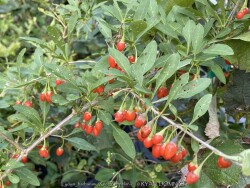

It's easy to grow your own goji berries! Though they seem like something exotic and tricky to grow, goji berries are durable, productive plants that can be grown without any special sprays, fertilizers, or even fussy pruning. Just plant them in full sun, stake them, and wait to reap a bounty of bright red fruits in autumn. Red Zeppelin® Goji Berry (Lycium barbarum 'Red Zeppelin') was selected especially for its very large fruit, which makes harvesting easier and more fun. A few things to note about growing goji berries: 1. they prefer an alkaline (higher pH) soil and don't grow well in acidic conditions. 2. goji has a natural habit of creating lots of thin, vine-like stems. To save space and make harvesting easier, we recommend that you put a very sturdy stake near the shrub after planting, then bundle the stems around the stake, tying with sturdy twine so that about one-quarter of the tops of the branches cascade downward, like a fountain. 3. Goji is generally a heavy feeder, and regular fertilizing is recommended. Apply a tomato or rose fertilizer in spring and again in early summer. The fruits are a bit bitter, like a green pepper, when they are fresh. To develop sweetness, they must be dried. If you don't have a dehydrator, spread ripe berries in a single layer on a piece of newspaper in a cool, bright spot with good air circulation. After about a week, they will feel leathery and can be stored in the fridge or freezer. Maintenance Notes: Does best in well-drained neutral to alkaline soils. At planting time, sink a 1x1" wood stake near the plant and bundle the canes around it. Let the tips of the stems cascade down, like a fountain. Each spring, move the tied point up further along the stake so that about one-quarter of the growth is above the tie. Then cut the branch tips back by 4-6". This encourages lateral branching, which is where most of the flowering and fruiting takes place. In Eastern Kansas, typically our 40 inches of rainfall is sufficient without extra water. All Proven Winners® plants are legally propagated, healthy and vigorous, true to name, and tagged with color pictures and growing information.
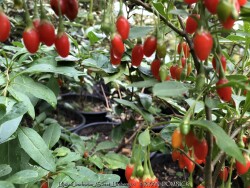

Gogi berries (Lycium barbarum) have purple flowers in mid-summer develop into jewel-like red fruits that are bitter and tomato-like when fresh but turn sweet when set out to dry for a week or so. Very high yielding, especially in alkaline soils. Sweet Lifeberry Gogi Berry (Lycium barbarum 'Sweet Lifeberry') was selected for its extra-sweet fruit which makes for easier harvesting. Maintenance Notes: Does best in well-drained neutral to slightly alkaline soils. At planting time, sink a 1x1" wood stake near the plant and bundle the canes around it. Let the tips of the stems cascade down, like a fountain. Each spring, move the tied point up further along the stake so that about one-quarter of the growth is above the tie. Then cut the branch tips back by 4-6". This encourages lateral branching, which is where most of the flowering and fruiting takes place. Grow superfruit in your own backyard! Fruits become especially sweet when dried. Goji berries are easy to grow in full sun, although some staking is recommended for maximum access to the nutrient-rich fruit. A pollinator is not needed. In Eastern Kansas, typically our 40 inches of rainfall is sufficient without extra water. All Proven Winners® plants are legally propagated, healthy and vigorous, true to name, and tagged with color pictures and growing information.


***Tree descriptions available with future update!***


Magnolia grandiflora 'Bracken's Brown Beauty' is one of the most cold hardy of the Southern Magnolias. Magnolias in general are a family of plants that have been around for millions of years and are among the most primitive of all flowers. In fact, most magnolia flowers evolved before bees and are thus pollinated by beetles. Magnolias generally have no serious pests or diseases. Any of the dwarf Southern Magnolia cultivars serve as a beautiful four seasons small tree or large shrub. Evergreen foliage is a shiny dark green with a brown-orange back that first emerges lighter green. If temperature stay above -10°F, foliage generally stays intact. If colder than that, it will shed its leaves like a deciduous tree when new growth occurs in April. Large tropical-looking white scented flowers bloom in late May and early June. Green cones, yes cones, follow in late summer with the cones opening up to yield beautiful red seeds. Seeds are viable but will not survive the winter here. Bracken's Brown Beauty Magnolias appreciate rich well-drained soil but will tolerate less than ideal clay soils. Sandy or rocky soils are tolerated if watering is sufficient. Magnolias can tolerate short periods of poor drainage but not consistent bog like conditions. Full sun is best but WELL-CARED for Magnolias can tolerate mostly shade in rich soils. This means do not use Magnolias under walnut trees, in dry shade, or exposed to north winds on the north side of a house. Being one of the few broadleaf evergreens hardy in zone 6, Bracken's Brown Beauty has many landscape uses. Several trees planted in a row or group will make an awesome wind and visual screen without the pest problems of coniferous evergreens. If ice or snow damage occurs, Magnolias have the ability to grow back reasonably quickly as opposed to most coniferous evergreens. In fact, Magnolias will come back from the ground is completely cut down and new growth from water sprouts will be rapid. Magnolias also make a great specimen tree or background for flowers and shrubs. Magnolias can be planted near a house without worrying about damaging root systems; they are very easily pruneable if they start getting too big. This highly-rated small landscape tree is perfect somewhere on your property!
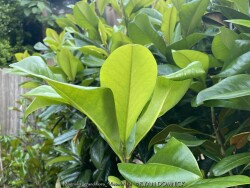

Magnolia grandiflora 'Victoria' is one of the most cold hardy of the Southern Magnolias. Magnolias in general are a family of plants that have been around for millions of years and are among the most primitive of all flowers. In fact, most magnolia flowers evolved before bees and are thus pollinated by beetles. Magnolias generally have no serious pests or diseases. Any of the dwarf Southern Magnolia cultivars serve as a beautiful four seasons small tree or large shrub. Evergreen foliage is a shiny dark green with a brown-orange back that first emerges lighter green. If temperature stay above -10°F, foliage generally stays intact. If colder than that, it will shed its leaves like a deciduous tree when new growth occurs in April. Large tropical-looking white scented flowers bloom in late May and early June. Green cones, yes cones, follow in late summer with the cones opening up to yield beautiful red seeds. Seeds are viable but will not survive the winter here. Victoria Hardy Southern Magnolias appreciate rich well-drained soil but will tolerate less than ideal clay soils. Sandy or rocky soils are tolerated if watering is sufficient. Magnolia's can tolerate short periods of poor drainage but not consistent bog like conditions. Full sun is best but WELL-CARED for Magnolias can tolerate mostly shade in rich soils. This means do not use Magnolias under walnut trees, in dry shade, or exposed to north winds on the north side of a house. Being one of the few broadleaf evergreens hardy in zone 6, Victoria Hardy Southern Magnolia has many landscape uses. Several trees planted in a row or group will make an awesome wind and visual screen without the pest problems of coniferous evergreens. If ice or snow damage occurs, Magnolias have the ability to grow back reasonably quickly as opposed to most coniferous evergreens. In fact, Magnolias will come back from the ground is completely cut down and new growth from water sprouts will be rapid. Magnolias also make a great specimen tree or background for flowers and shrubs. Magnolias can be planted near a house without worrying about damaging root systems; they are very easily pruneable if they start getting too big. This highly-rated small landscape tree is perfect somewhere on your property!


***Description for this plant available with future update!***
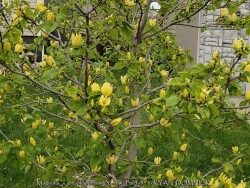

Yellow Flowering Magnolia (Magnolia x brooklynensis 'Yellow Bird') is a rare jewel in the landscape: a tree with giant canary yellow flowers! Yellow Bird is an upright, conical to pyramidal, large deciduous tree that can grow 40 feet tall in Kansas. This magnolia would be a fine residential specimen in sheltered locations with moist, rich soil with plenty of space to spread. Magnolias in general are a family of plants that have been around for millions of years and are among the most primitive of all flowers. In fact, most magnolia flowers evolved before bees and are thus pollinated by beetles. Magnolias generally grow in moist, well drained soils in sun or shade. They have no serious pests or disease problems.
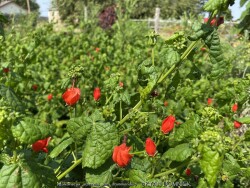

Red Turk's Cap, is also known as Malvaviscus arboreus var. drummondii
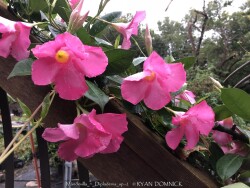

There are many varieties of the tropical vining flowers called Mandevilla / Dipladenia sp. The five-petal flowers are very showy and fragrant, blooming all summer until frost. Blooming will also decrease with cooler fall night temperatures. Flower colors typically coming in shades of pink, red, and white, occasionally with yellow throats. Mandevillas thrive in warm, humid weather as a summer patio plant or annual. If growing as a potted plant and trying to overwinter, it is very difficult as these plants do not like low humidity or low light; best to replace each year. Watch out for mealybugs and spider mites indoors.
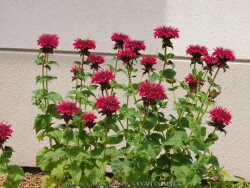

Fireball Dwarf Beebalm / Monarda, is also known as Monarda x didyma 'Fireball'
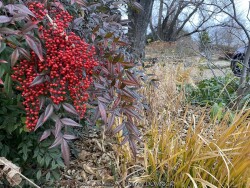

Nandina domestica is also called "Nandina" or "Heavenly Bamboo" despite not spreading or being related to bamboo at all. It is native to warm temperate climates in China. Bamboo-like foliage is very attractive with new growth emerging coppery peach with shades of pink and red in spring. During the summer, the foliage maintains a glossy deep to medium green color with no pest problems. White flowers appear which eventually turn into red fruits in the fall. Most birds do not like the fruit so they persist very well into winter down to about 0° F before freeze-drying to a reddish brown color and falling off. Often around Christmas time, the berries make a spectacular show combining classic colors of red and green in the winter landscape. The berries can be poisonous to some birds if they eat too many and all other food sources are depleted. This is a problem in your yard, please remove the fruits in the winter or before we have an arctic blast in which birds get desperate and will eat anything. The foliage is evergreen down to about -5° F and if colder, will simply become a deciduous shrub that year. If winter temperatures reach -10 or with strong winds, nandina will die to the ground like a perennial and come up from the base in April. In some parts of the country where winterkill never happens, nandina are invasive. (fruits spread by birds) This is likely in the Southeast and Texas south of zone 8b with plenty of rainfall. In those areas nandina will slowly take over the forest and displace native plants. There are many fruitless cultivars that can be used if invasiveness is a problem. In Kansas and in zone 5-7, This is never a problem because extreme winters keep the plant "in-check" and kill any seedlings trying to germinate. This shrub has a four-season appeal and is great for adding interest to Kansas landscapes in the winter. Best growth in Lawrence, KS (zone 6a) occurs when planted on South or West exposures benefiting from the hot micro climate. Nandina will also grow in just about any soil with full shade to full sun. If planted in full shade, growth will be very slow and extreme winters may kill them if not established; plant in spring only in this situation. Nandina look best in small to large groups. After established, its a "once it's there it's there forever" plant with very little maintenance. The only maintenance is cutting back winter kill occasionally or pruning to a more desirable mounded shape. It is worth noting that dwarf fruitless cultivars are less hardy in marginal zone 6 climates because of reduced ability to quickly recover from an occasional extreme winter.
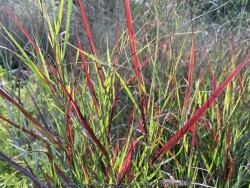

>>>>>Forms a dense, upright clump of blue-green leaves that turn wine red in early summer. Purple flower panicles appear just above the foliage in late summer. This petite red grass is ideal for containers.>>>>>>All Proven Winners® plants are legally propagated, healthy and vigorous, true to name, and tagged with color pictures and growing information.
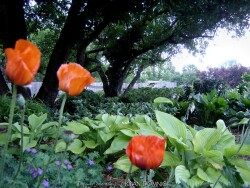

>>>>>Ultra cold-hardy plants from northern climates normally dislike our long hot humid summers; although we are on the Southern edge of this plants adaptability, it still survives reasonably well here. Look for a cold microclimate planting location such as East or North exposure.>>>>>
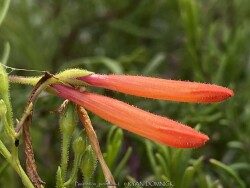

***Description for this perennial available with future update!***
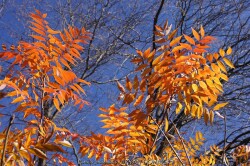

>>>>>In Eastern Kansas, this tree species performs WELL with just about everything nature has to challenge it! Extreme heat and drought are tolerated. Cold tolerance is no problem in our zone 6. No disease or pest problems. Great plant for berms, hot West or South exposures, and most any other garden situations in full sun. Will tolerate clay soils and extra moisture in summer. Fall color is variable in the Northern part of its range; sometimes an early frost wipes out the foliage before color can form. Interestingly, Chinese pistache is the only tree to develop fall color in the low deserts of the Southwest and as far South as Orlando, unaffected by heat and not dependant on cool night temperatures. In Stillwater, Oklahoma, chinese pistache would often hold color into December.


Chinese Mayappple >>>>> ***Description for this perennial available with future update!***


***Description for this plant available with future update!***
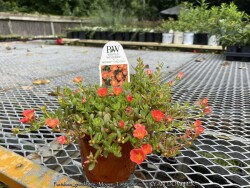

***Description for this plant available with future update!***


***Description for this plant available with future update!***
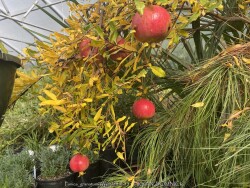

Hardy Pomegranite (Tropical), is also known as Punica granatum 'Wonderful'
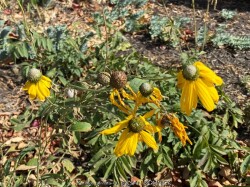

***Description for this perennial available with future update!*** Mexican Hat, is also known as Ratibida columnifera
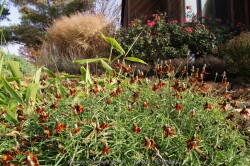

Red Mexican Hat, is also known as Ratibida columnifera 'Red'
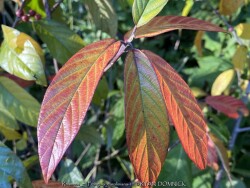

***Shrub descriptions available with future update!***
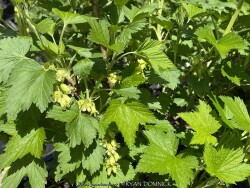

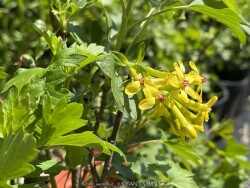

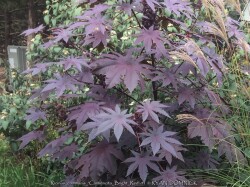

Castor Bean (Ricinus communis) is a giant annual grown for its large star shaped leaves and highly ornamental summer flowers and spiky seed pods. Being one of the fastest growing plants, it will germinate from a seed and can reach 5 feet tall in one month. Ultimate height at the end of the season is usually 8 to 12 feet. Growth rate, however, is directly proportional to available water and soil quality. In poor dry soil areas, a height of 3 feet may be achieved with some flowering by fall. In the landscape, this amazing annual can be used for lots of coverage is needed quick. Maintenance is considered medium. Staking by mid-summer may be necessary to prevent plants from blowing over. All dead foliage should be removed right before or promptly after the first fall freeze. At that time, seeds can be clipped off and immediately planted if you would like castor beans to return next spring. Seeds may also be harvested and stored and will not survive winter outside unless planted or covered by a deep layer of mulch. If planting seed in the spring, wait till soil warms up in early May. Seeds germinate quickly and extremely easily with almost no effort. Castor Bean plants do not easily overwinter indoors as a house plant due to their need for tropical growing conditions and high humidity. Another word of caution is that castor bean seeds are extremely toxic. However there is almost never any poisonings because the seed tastes so bad if chewed that anyone in their right mind would spit it out. Seeds that are swallowed whole usually survive the digestive system and not cause poisoning. The plant itself is not very toxic so there is no reason not to grow it. If you are concerned about the beans, or you have small children, just cut off and dispose of the flowers after they bloom and before seeds ripen. You'll have plenty of time (1-2 months) before the bright red spiky seed pods open and turn brown. Purple Castor Bean (Ricinus communis 'Carmencita Bright Red') features bright reddish-purple foliage and dark red seed pods. Overall size is smaller with slower growth rate.


Castor Bean (Ricinus communis) is a giant annual grown for its large star shaped leaves and highly ornamental summer flowers and spiky seed pods. Being one of the fastest growing plants, it will germinate from a seed and can reach 5 feet tall in one month. Ultimate height at the end of the season is usually 8 to 12 feet. Growth rate, however, is directly proportional to available water and soil quality. In poor dry soil areas, a height of 3 feet may be achieved with some flowering by fall. In the landscape, this amazing annual can be used for lots of coverage is needed quick. Maintenance is considered medium. Staking by mid-summer may be necessary to prevent plants from blowing over. All dead foliage should be removed right before or promptly after the first fall freeze. At that time, seeds can be clipped off and immediately planted if you would like castor beans to return next spring. Seeds may also be harvested and stored and will not survive winter outside unless planted or covered by a deep layer of mulch. If planting seed in the spring, wait till soil warms up in early May. Seeds germinate quickly and extremely easily with almost no effort. Castor Bean plants do not easily overwinter indoors as a house plant due to their need for tropical growing conditions and high humidity. Another word of caution is that castor bean seeds are extremely toxic. However there is almost never any poisonings because the seed tastes so bad if chewed that anyone in their right mind would spit it out. Seeds that are swallowed whole usually survive the digestive system and not cause poisoning. The plant itself is not very toxic so there is no reason not to grow it. If you are concerned about the beans, or you have small children, just cut off and dispose of the flowers after they bloom and before seeds ripen. You'll have plenty of time (1-2 months) before the bright red spiky seed pods open and turn brown. Red Flowered Castor Bean (Ricinus communis 'Gibsonii') features bright reddish-green foliage and bright red seed pods.
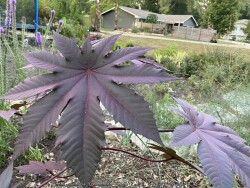

Castor Bean (Ricinus communis) is a giant annual grown for its large star shaped leaves and highly ornamental summer flowers and spiky seed pods. Being one of the fastest growing plants, it will germinate from a seed and can reach 5 feet tall in one month. Ultimate height at the end of the season is usually 8 to 12 feet. Growth rate, however, is directly proportional to available water and soil quality. In poor dry soil areas, a height of 3 feet may be achieved with some flowering by fall. In the landscape, this amazing annual can be used for lots of coverage is needed quick. Maintenance is considered medium. Staking by mid-summer may be necessary to prevent plants from blowing over. All dead foliage should be removed right before or promptly after the first fall freeze. At that time, seeds can be clipped off and immediately planted if you would like castor beans to return next spring. Seeds may also be harvested and stored and will not survive winter outside unless planted or covered by a deep layer of mulch. If planting seed in the spring, wait till soil warms up in early May. Seeds germinate quickly and extremely easily with almost no effort. Castor Bean plants do not easily overwinter indoors as a house plant due to their need for tropical growing conditions and high humidity. Another word of caution is that castor bean seeds are extremely toxic. However there is almost never any poisonings because the seed tastes so bad if chewed that anyone in their right mind would spit it out. Seeds that are swallowed whole usually survive the digestive system and not cause poisoning. The plant itself is not very toxic so there is no reason not to grow it. If you are concerned about the beans, or you have small children, just cut off and dispose of the flowers after they bloom and before seeds ripen. You'll have plenty of time (1-2 months) before the bright red spiky seed pods open and turn brown. Purple Castor Bean (Ricinus communis 'New Zealand Purple') features bright purple foliage and dark red seed pods.


Chinese Sacred Lily (Rohdea japonica) is a tropical-looking evergreen herbaceous perennial native to China and Japan. They are considered the ultimate dry-shade plant for eastern Kansas landscapes. They have everything a gardener might ask for; dependable dark green foliage, colorful red long-lasting fruits, evergreen during winter, and ease of care with very low maintenance. Evergreen foliage is daylily-like and hardy to about -10°F. If it gets colder than that, rohdea will be deciduous with no detrimental effects. The red fruits in the crowns of established plants persist many months through the winter! Rohdeas are also not the best choice for full sun. While they will survive, they will get foliage burn in the summer when over 100°F in afternoon sun. With poisonous foliage, these plants resist deer and rabbit browsing. Rohdea tolerates most soils except for poorly drained ones. Growth is quite slow with young plants but speeds up with establishment and rich soils with regular water. Established plants have thrived in our Lawrence Kansas zone 6a display garden for over 15 years enduring temperatures as low as -18°F. and periods with many days in a row in the single digits and negative low temps. Repeated or successive cold winters with complete foliage loss can be an issue with this and many evergreen zone 6/7 plants. One occasional difficult winter followed by mild winters is more tolerable. It's tolerance for deep shade makes up for this though. What a great plant for the dry shade garden!
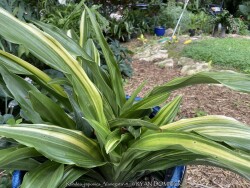

Chinese Sacred Lily (Rohdea japonica) is a tropical-looking evergreen herbaceous perennial native to China and Japan. They are considered the ultimate dry-shade plant for eastern Kansas landscapes. They have everything a gardener might ask for; dependable dark green foliage, colorful red long-lasting fruits, evergreen during winter, and ease of care with very low maintenance. Evergreen foliage is daylily-like and hardy to about -10°F. If it gets colder than that, rohdea will be deciduous with no detrimental effects. The red fruits in the crowns of established plants persist many months through the winter! Rohdeas are also not the best choice for full sun. While they will survive, they will get foliage burn in the summer when over 100°F in afternoon sun. With poisonous foliage, these plants resist deer and rabbit browsing. Rohdea tolerates most soils except for poorly drained ones. Growth is quite slow with young plants but speeds up with establishment and rich soils with regular water. Established plants have thrived in our Lawrence Kansas zone 6a display garden for over 15 years enduring temperatures as low as -18°F. and periods with many days in a row in the single digits and negative low temps. Repeated or successive cold winters with complete foliage loss can be an issue with this and many evergreen zone 6/7 plants. One occasional difficult winter followed by mild winters is more tolerable. It's tolerance for deep shade makes up for this though. What a great plant for the dry shade garden! Rohdea japonica 'Variegata' is a beautiful variegated variety with dark green and yellow stripes; very dramatic in winter!
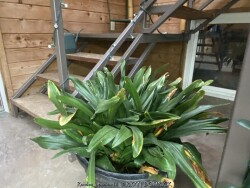

Chinese Sacred Lily (Rohdea japonica) is a tropical-looking evergreen herbaceous perennial native to China and Japan. They are considered the ultimate dry-shade plant for eastern Kansas landscapes. They have everything a gardener might ask for; dependable dark green foliage, colorful red long-lasting fruits, evergreen during winter, and ease of care with very low maintenance. Evergreen foliage is daylily-like and hardy to about -10°F. If it gets colder than that, rohdea will be deciduous with no detrimental effects. The red fruits in the crowns of established plants persist many months through the winter! Rohdeas are also not the best choice for full sun. While they will survive, they will get foliage burn in the summer when over 100°F in afternoon sun. With poisonous foliage, these plants resist deer and rabbit browsing. Rohdea tolerates most soils except for poorly drained ones. Growth is quite slow with young plants but speeds up with establishment and rich soils with regular water. Established plants have thrived in our Lawrence Kansas zone 6a display garden for over 15 years enduring temperatures as low as -18°F. and periods with many days in a row in the single digits and negative low temps. Repeated or successive cold winters with complete foliage loss can be an issue with this and many evergreen zone 6/7 plants. One occasional difficult winter followed by mild winters is more tolerable. It's tolerance for deep shade makes up for this though. What a great plant for the dry shade garden!
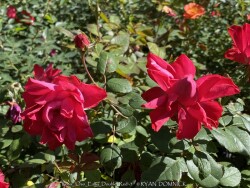

This rose earns its spot in the Winner's Circle! There's so much to love about Oso Easy Double Red® rose - its lush, deep red color. The way the blooms are held on long stems, well above the foliage, for a truly memorable display. And speaking of foliage, it's a beautiful, lustrous green with excellent resistance to powdery mildew and black spot, so it stays looking good all season. No need to deadhead to keep those beautiful blooms coming, too! Oso Easy Double Red rose is a bit of a bigger plant - about 3-4'/.9-1.2 m tall and wide, but give it enough space in a sunny location, and you've given yourself the gift of an easy-care rose that you'll love to look at all season long. In Lawrence Kansas, performance has been impressive and low maintenance. Currently, no serious pest problems exist but we are careful not to recommend planting roses in large mass groupings in case a pest or disease like Rose Rosette Virus (RRV) becomes a problem. Mixed small plantings of roses and non-host plants may slow the spread of RRV in landscape plantings. As with most roses, thorns may be an issue with children or pets. Usually rose thorns are short and don't cause any serious injury: it creates more of a life lesson about respecting and being careful around the dangers in our world. All Proven Winners® plants are legally propagated, healthy and vigorous, true to name, and tagged with color pictures and growing information.
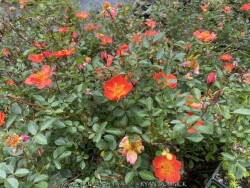

Spice up your landscape! Oso Easy® Paprika rose is a landscape classic - and now, it has a modern update. Meet Oso Easy Hot Paprika® - like its namesake, it flowers from early summer through frost on a versatile, low-growing plant. It also shares its outstanding hardiness and disease resistance. Its flowers, however, light up the garden in an electric glowing orange for a bold new look. Available in better garden centers in spring 2018. In Lawrence Kansas, performance has been impressive and low maintenance. Currently, no serious pest problems exist but we are careful not to recommend planting roses in large mass groupings in case a pest or disease like Rose Rosette Virus (RRV) becomes a problem. Mixed small plantings of roses and non-host plants may slow the spread of RRV in landscape plantings. As with most roses, thorns may be an issue with children or pets. Usually rose thorns are short and don't cause any serious injury: it creates more of a life lesson about respecting and being careful around the dangers in our world. All Proven Winners® plants are legally propagated, healthy and vigorous, true to name, and tagged with color pictures and growing information.
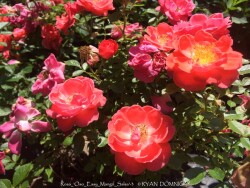

If you think roses are for very proper, formal gardens, think again. This rebel has intense, amazing color: shades of ruby-red grapefruit, summer sunsets, and those fancy tropical drinks with umbrellas in them. The continuous blooms cover the tidy mound of dark, glossy foliage. This is a wonderful choice for mass plantings or adding unusual color to mixed borders In Lawrence Kansas, performance has been impressive and low maintenance. Currently, no serious pest problems exist but we are careful not to recommend planting roses in large mass groupings in case a pest or disease like Rose Rosette Virus (RRV) becomes a problem. Mixed small plantings of roses and non-host plants may slow the spread of RRV in landscape plantings. As with most roses, thorns may be an issue with children or pets. Usually rose thorns are short and don't cause any serious injury: it creates more of a life lesson about respecting and being careful around the dangers in our world. All Proven Winners® plants are legally propagated, healthy and vigorous, true to name, and tagged with color pictures and growing information.
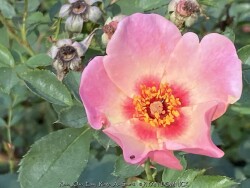

When you're this colorful, you only need five petals for big impact! The pleasing flowers of Ringo All-Star rose may look simple at first, but this plant packs in a lot of interest. The flowers start out a rich melon-orange with a cherry-red center. As each one ages, it transforms to lavender and pink, creating a look of multiple colors on one plant. A crown of fluffy yellow anthers bedecks the center and attracts pollinators. As with all Proven Winners roses, Ringo All-Star is disease resistant and low maintenance. No need to trim or deadhead to keep those fab flowers coming all season! In Lawrence Kansas, performance has been impressive and low maintenance. Currently, no serious pest problems exist but we are careful not to recommend planting roses in large mass groupings in case a pest or disease like Rose Rosette Virus (RRV) becomes a problem. Mixed small plantings of roses and non-host plants may slow the spread of RRV in landscape plantings. As with most roses, thorns may be an issue with children or pets. Usually rose thorns are short and don't cause any serious injury: it creates more of a life lesson about respecting and being careful around the dangers in our world. All Proven Winners® plants are legally propagated, healthy and vigorous, true to name, and tagged with color pictures and growing information.
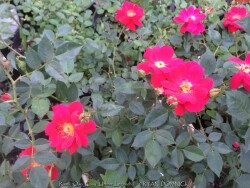

A bright red rose with non-stop blooms! Oso Easy® Urban Legend® is a bright and vigorous member of this best-selling series of disease-resistant landscape roses. True-red, semi-double flowers in early summer and continue through the first hard frost. A crown of lush yellow stamens in the center add interest and contrast. Dark green glossy foliage resists powdery mildew and black spot.In Lawrence Kansas, performance has been impressive and low maintenance. Currently, no serious pest problems exist but we are careful not to recommend planting roses in large mass groupings in case a pest or disease like Rose Rosette Virus (RRV) becomes a problem. Mixed small plantings of roses and non-host plants may slow the spread of RRV in landscape plantings. As with most roses, thorns may be an issue with children or pets. Usually rose thorns are short and don't cause any serious injury: it creates more of a life lesson about respecting and being careful around the dangers in our world. All Proven Winners® plants are legally propagated, healthy and vigorous, true to name, and tagged with color pictures and growing information.
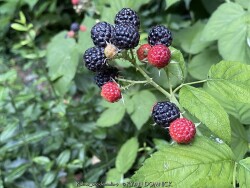

Raspberry (Rubus occidentalis) is an "easy to grow" edible fruit that is worth growing in Kansas. Store-bought raspberries are expensive and don't taste as good as garden grown fruits. All cultivars of raspberries have perennial roots, but most top shoots only live for two years. (meaning shoots grow in the first growing season and fruits grow on those shoots during the second growing season) The cycle is repeated; maintenance involves removing old canes after decline or death. Raspberries are vigorous and can be locally invasive in the garden but rarely invasive in the wild. They propagate by basal shoots (also known as suckers) spreading some distance from the main plant. After establishment, it is high maintenance if it has already filled the space and you don't want it to spread any further so plan accordingly. In the landscape, raspberry and blackberry mix well into garden designs with ornamental plants as long as you create it's own area (like a background fence to train plants on) The main difference between raspberry and blackberry are that the fruit releases from the raspberry differently. The "torus" or inside center of the fruit is hollow and releases from the stem with raspberry. With Blackberry, the "torus" or center "picks with" the fruit giving a solid fruit to eat. (just in case you have always wondered) Native Black Raspberry (Rubus occidentalis) is a true native plant to Kansas lightly shaded woods, open moist prairies, disturbed areas (especially those that are logged or cut), and near streams and lakes, trails or roadways. Ripe fruit is black instead of red. Fruit production is rather brief compared to commercially available varieties (one big flush of fruits ripen for a couple weeks and that's it) Foliage is bluish-green with powdery white flocked backsides and irridescent bluish-purple stems add nice ornamental value! Also called black cap raspberry.
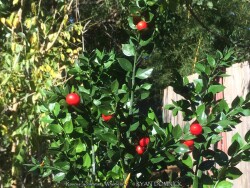

Wheelers Butcher's Broom (Ruscus aculeatus 'Wheelers') is the ultimate dry-shade plant for eastern Kansas landscapes. They are native to dry shaded woodland and hedgerows in England and along coastal cliffs. Butcher's Broom has everything a shade gardener might ask for; dependable dark green foliage, colorful red long-lasting fruits, evergreen during winter, and ease of care with very low maintenance. "Leaves" are actually "cladodes" (flattened, leaf-like stem tissue that photosynthesises) Evergreen foliage is bristly, shrub-like, and hardy to about -10°F. If it gets colder than that, ruscus will be deciduous and will slowly recover in summer. The red berries which sit squarely on the middle of the "leaves" on established plants persisting for a few months through the fall! Ruscus tolerate deep shade but some filtered or morning sun is best for optimal growth in our colder climate. With prickly foliage, these plants resist deer and rabbit browsing. Ruscus tolerates most soils except for poorly drained ones. Growth is quite slow with young plants but speeds up with establishment and rich soils with regular water. It is best to start with large plants as establishment and full winter-hardiness will occur much faster. A thick layer of mulch greatly helps with cold hardiness. Established plants have thrived in our Lawrence Kansas zone 6a display garden for over 10 years enduring temperatures as low as -18°F. Ruscus aculeatus 'Wheeler's' is self-fertile, not needing a male plant for pollination.
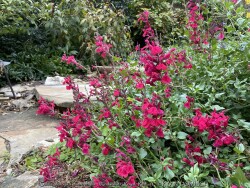

>>>>>Red sage is a wonderful heavily flowering perennial found in Texas and higher election Mexico. Foliage is evergreen to about 0°, Beyond that, it becomes a deciduous perennial hardy to about -15 before complete death would occur. During years in which the foliage remains evergreen, and blooms on old word covering the plants during the month of April. If dieback occurs, blooms will still be dramatic but will be delayed until May on new growth. If Diback does not occur naturally, it is recommended to cut back anyways every 2 to 3 years to maintain bushiness. During the summer, foliage maintains very well with heat and drought with sporadic blooming. Another flush of heavy flowering occurs in fall and continues until hard freezes sometimes into November in our Lawrence Kansas zone6 climate. In the landscape, Red Sage is best on a hot south or west side of a house, on a south side of a berm, or any sunny garden area with some North wind protection. The flower power is so great that it would even be worth using red sage as a short-lived perennial or annual though. Growth in containers is amazing when used as an annual. As with any zone6 perennials, be sure to mulch 2 to 3 inches deep to guard against temperatures below -10F. Red sage needs well drained soils on the dry side but summer irrigation is OK. There is quite a bit of variability within the salvia Greggy species with lots of different colors and heights ranging from 1 to 4 feet. This is a true butterfly magnet; I have seen hundreds of yellow sulfur butterflies visiting at the same time as shown in one of our pictures.
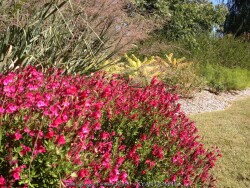

>>>>>In Lawrence, KS (zone 6a), many dozen established specimens survived -17 degrees F. During the arctic blast of February, 2021, lows down to -17 degrees F on Feb 16th, 2021 were recorded. The longevity of this cold blast was also impressive: 10 days on a row with highs of 10-15 degrees F or lower, 8 nights of lows in the single digits and negatives, and 36 strait hours of 0 degrees F and mostly lower. All survivors had winter sun with South exposures, those without perrished. Repeated or successive cold winters with complete foliage loss seem can be an issue with this and many evergreen zone 6/7 plants. One occasional difficult winter followed by mild winters is more tolerable. This is, however, a very vigorous growing plant so generally will recover in one summer. Avoid North-facing exposures, North sides of a berm, and spots with excessive snow accumulation.
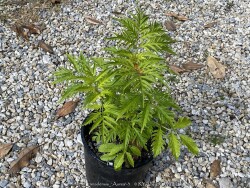

***Shrub descriptions available with future update!***
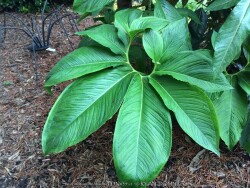

>>>>>Voodoo lily is a perennial tuber generally grown as a curiosity for its interesting foliage. The single leaf consists of a stalk (petiole) with mottled pinkish-gray and olive green coloration. The single intricate leaf has horizontal sections giving it a tropical umbrella-like effect. Larger tubers (about the size of a grapefruit or larger) may produce a single "flower" in spring before the foliage appears. The "flower" is actually a large shiny purple to maroon ruffled spathe. When in bloom it produces an odor like a dead animal for 1 day. This is intended to attract the carrion flies that are its natural pollinators. It is possible to overwinter these in the ground in Kansas by placing a 6-12" mound of mulch over deeply planted tubers. New growth will usually be delayed until June but quickly regains full height and will get bigger each year; buried tubers are hardy to zone 6. If growing as a potted patio plant, move into dark garage or basement and keep above 32 Degrees F. Allow to go dormant as needed with little care, just cut off dead foliage and place back out in April or May with a time-release fertilizer.
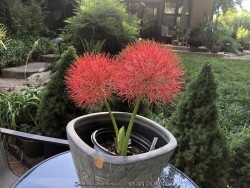

Jaw-dropping flowers! African Blood Lily (Scadoxus multiflorus) produces a mass of tiny florets with prominent stamens clustered in one large, orange-red, softball-sized, bottlebrush, round flower. It is so eye-catching it wins a place in many summer gardens. Reminds me of a giant red dandelion seed head! This South African native is 8"-10" tall and provides bright color in the late summer garden. Bold, broad green leaves emerge after the flowering is over. Although it is said to need partial shade, we have this pest resistant, adaptable plant happily blooming in full sun; blooms mid-summer. Winter hardiness: zones 7/8-10. Plant bulb outside as an annual before flowering: planting already flowered bulbs is not recommended unless you dig it up for winter storage. If grown as a potted plant, bring container indoors and either grow them as a houseplant in a lighted area. Foliage will look good for a few months before finally dying back. Eventually allow bulb to go dormant stopping the water and store bulbs dry in the container with soil anywhere between 40-70 degrees F. African Blood Lily will bloom year after year when grown as a potted plant; late to emerge in the spring so don't throw it out! It is possible to overwinter these in the ground in Kansas by placing a giant 12" mound of mulch over deeply planted bulbs. New growth will usually be delayed until late May/early June but quickly regains full height. In our trial gardens in Lawrence, KS (zone 6a), a bulb planted over 8" deep and next to a South-facing brick wall with 6-8" of leaf mulch survived -17 degrees F. During the arctic blast of February, 2021, lows down to -17 degrees F on Feb 16th, 2021 were recorded. The longevity of this cold blast was also impressive: 10 days on a row with highs of 10-15 degrees F or lower, 8 nights of lows in the single digits and negatives, and 36 straight hours of 0 degrees F and mostly lower.